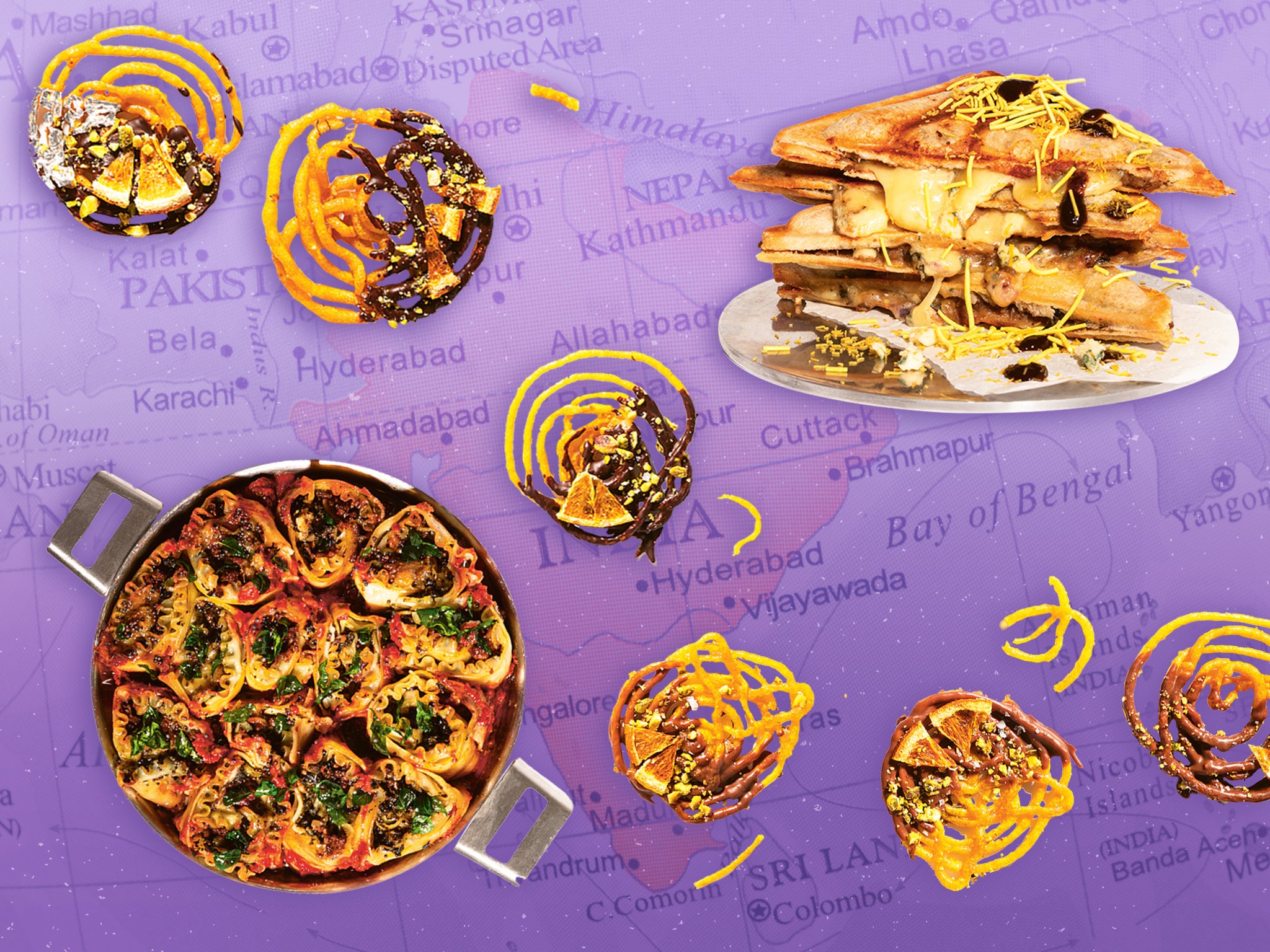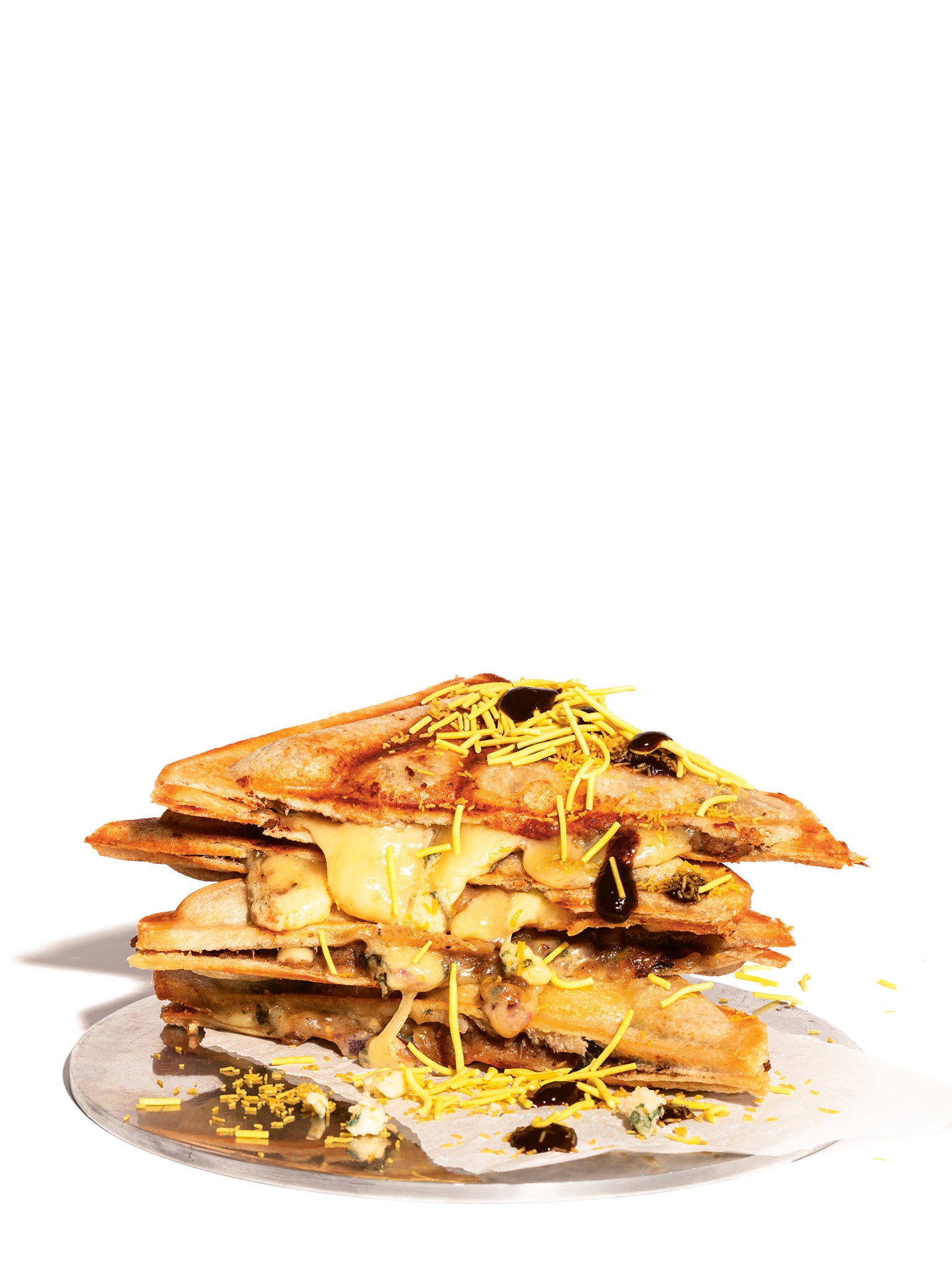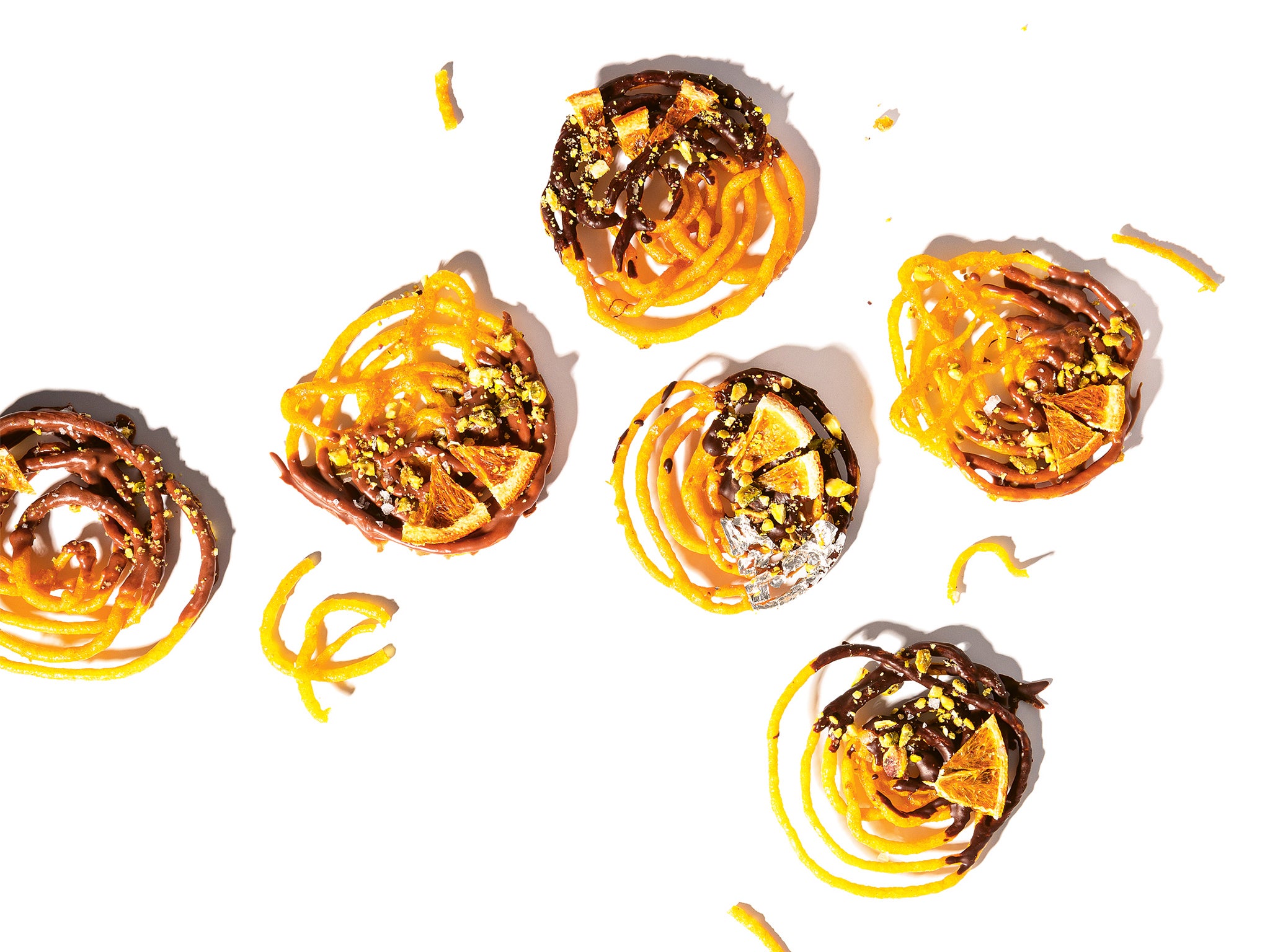Third-culture feasts: Boundary blending British Indian recipes from Gurdeep Loyal
From a Stilton and tamarind toastie to chocolate orange jalebi, ‘Mother Tongue’ by Gurdeep Loyal is a celebration of the hybrid cooking of second-generation migrants. Prudence Wade ‘borrows’ three recipes

Your support helps us to tell the story
From reproductive rights to climate change to Big Tech, The Independent is on the ground when the story is developing. Whether it's investigating the financials of Elon Musk's pro-Trump PAC or producing our latest documentary, 'The A Word', which shines a light on the American women fighting for reproductive rights, we know how important it is to parse out the facts from the messaging.
At such a critical moment in US history, we need reporters on the ground. Your donation allows us to keep sending journalists to speak to both sides of the story.
The Independent is trusted by Americans across the entire political spectrum. And unlike many other quality news outlets, we choose not to lock Americans out of our reporting and analysis with paywalls. We believe quality journalism should be available to everyone, paid for by those who can afford it.
Your support makes all the difference.I’ve always had a taste for the salty bite of Stilton, particularly those cheeses made in Leicestershire by makers such as Long Clawson Dairy and Tuxford and Tebbutt Creamery, and the masala tamarind potatoes in this recipe bring out the cheese’s rich intensity,” says food writer Gurdeep Loyal.
“It’s all toasted until everything melts together, revealing a spectrum of spiced savouriness in every bite. This is unapologetic British Indian hybridity at its utmost – multifaceted flavour-on-flavour made in toastie form – and it is sublime.”
Stilton and tamarind Mumbai toastie

Makes: 2
Ingredients:
For the tamarind potatoes:
1 tbsp ghee
1½ tsp coriander seeds, crushed
1½ tsp fennel seeds, crushed
1 large potato, boiled and mashed
1 small red onion, very finely chopped
1 green chilli, very finely chopped
1 tsp fine sea salt
2 tbsp gunpowder masala, or garam masala, plus 1 tsp
4 tbsp Tamarind, Date & Mint Sauce, or bottled tamarind table ketchup, or brown sauce, plus more to serve
2 tbsp chopped coriander leaves
For the toasties:
4 thick slices of white bread
2 tbsp unsalted butter, very soft, plus more for spreading
4 tbsp thick sev, plus more to serve
150g Stilton cheese, crumbled
Method:
1. To make the tamarind potatoes, gently heat the ghee in a saucepan, then add the crushed coriander and fennel seeds, sizzling for one minute. Mix in the mashed potato, red onion, green chilli, salt and gunpowder or garam masala. Turn up the heat to medium, add the tamarind sauce, ketchup or brown sauce and cook for two to three minutes. Finish by mixing through the coriander, then leave to cool.
2. Heat a toastie maker or sandwich grill so it’s hot. (If you don’t have one, these can just as easily be made in a griddle or frying pan).
3. Spread the inside of two pieces of bread with butter, then spoon over a thick layer of the tamarind potatoes. Sprinkle over the thick sev for some crunch. Butter the other slices of bread then generously crumble over the Stilton. Press the two slices together.
4. Mix the two tablespoons of very soft butter with the one teaspoon of gunpowder or garam masala, and spread over the outsides of the sandwiches. Grill for three to four minutes, until the bread is nicely toasted and the Stilton oozing out. Serve with extra tamarind sauce for dipping and thick sev for even more crunch.
Kasundi keema lasagne rolls

Loyal grew up eating keema – a type of spiced mince, often made with lamb.
In this dish, he’s reinvented keema by adding cheese, cavolo nero, mustard and more – and fashioned it into lasagne rolls.
Serves: 4
Ingredients:
For the kasundi keema:
2 tbsp ghee
2 large onions, finely chopped
1 tbsp coriander seeds, crushed
1 tbsp black mustard seeds
1 tbsp cumin seeds
8 garlic cloves, very finely chopped
2 tbsp finely grated fresh ginger
2 tsp chilli flakes
500g minced lamb (20% fat)
2 tbsp garam masala
2 tsp fine sea salt
5 tbsp tomato purée
2 tbsp dark brown sugar
3 tbsp apple cider vinegar
½ 400g can of chopped tomatoes
For the cheese paste:
200g mature cheddar cheese, grated
2 tsp cumin seeds, crushed
3 tbsp coarse semolina
1 tsp coarsely ground black pepper
1 egg, lightly beaten
For the greens:
200g cavolo nero, coarse stalks removed
1 tbsp English mustard
4 garlic cloves, very finely chopped or grated
4 tbsp lemon juice
For the lasagne rolls and tarkha:
10-12 lasagne sheets
500g jar of tomato pasta sauce
2 tbsp vegetable oil
30-35 fresh curry leaves
1½ tbsp black mustard seeds
1 tsp chilli flakes
Method:
1. To make the keema, heat the ghee in a large pan, add the onions and cook for seven to eight minutes until golden.
2. Next add the coriander, mustard and cumin seeds, cooking for another two to three minutes, before adding the garlic, ginger and chilli flakes. Now add the lamb, browning for four to six minutes before mixing through the garam masala and salt. Finally add the tomato purée, sugar and vinegar, along with the tomatoes. Simmer and reduce for five to seven minutes, then set aside.
3. To make the cheese paste, combine all the ingredients together into a crumbly mixture.
4. For the greens, boil the cavolo nero in salted water for five to six minutes until tender, then blend with the mustard, garlic and lemon juice into a thick smooth paste. Add a little water if needed, then let it cool.
5. Preheat the oven to 200C fan.
6. Cover the lasagne sheets with boiling water and leave for four to five minutes to soften a little. Slice each lasagne sheet down the middle lengthways, making two strips ready for rolling.
7. Take one pasta strip, spread with one tablespoon of the mustard greens, sprinkle over some cheese paste and finally add a spoon of keema. Roll up tightly into a snail. Repeat to form all the lasagne rolls.
8. Pour the jarred tomato pasta sauce into an ovenproof dish and tightly pack in the lasagne rolls.
9. Cover with foil and bake for 25 minutes, then remove the foil and bake for a final 10-15 minutes, until piping hot and crusty on top.
10. Meanwhile, for the tarkha, heat the vegetable oil in a pan, then add the curry leaves, mustard seeds and chilli flakes. Sizzle for one minute, then drizzle over the baked lasagne rolls just before serving.
Chocolate orange jalebi

This classic Indian dessert is given a British twist with Terry’s-inspired chocolate orange flavours.
Makes: 25-30
Ingredients:
For the batter:
180g plain flour, plus 1 tbsp more if needed
1 tbsp cornflour
2 tbsp rice flour
1 tbsp fine cornmeal
2 tbsp natural yoghurt
1L sunflower oil, plus 1 tsp
1 tbsp lemon juice
¼ tsp bicarbonate of soda
For the syrup:
400g granulated sugar
2 tbsp finely grated orange zest
10 green cardamom pods, split
2-3 drops orange extract
15 saffron strands
2 tbsp orange juice
1 tbsp lemon juice
To serve:
200g milk or dark chocolate, melted
Pistachio nibs
Thin orange segments, or finely grated orange zest
Sea salt flakesSilver leaf (optional)
Method:
1. To make the batter, whisk the 180 grams of plain flour, the cornflour, rice flour and fine cornmeal together in a mixing bowl. In a separate jug, whisk together the yogurt, one teaspoon of sunflower oil, the lemon juice and 185 millilitres of cold water.
2. Slowly pour the wet ingredients into the dry, whisking for two to three minutes until you have a smooth dense pancake batter; if needed, add another 25-50 millilitres of water. It should be pourable, but also thick enough to drop in smooth ribbons, so the coiled spirals keep their shape when fried; you don’t want it too runny or too thick.
3. Cover and rest for 10 minutes.
4. Meanwhile, to prepare the syrup, put the sugar, orange zest, bashed cardamom pods, orange extract and saffron in a deep frying pan, along with 275 millilitres of water. Bring to the boil, then reduce the heat to a simmer for three to four minutes, until the syrup reaches a one-string consistency. Finally, add the orange and lemon juices, whisking well. Keep warm over a low heat to one side; warm syrup will soak into the fried jalebi shells more easily.
5. Heat one litre of oil to 160C in a deep frying pan or wok. Keep it at this temperature, not too high, or the jalebis will cook too quickly.
6. Add the bicarbonate of soda to the rested batter and whisk thoroughly, then pour into a squeezy bottle with a small (three millimetre) nozzle, or a plastic piping bag snipped at the end. When the oil is ready, swiftly pipe the batter into the hot oil in spiralling snail shapes, pressing the bottle hard as you coil from the inside out, then coil back from the outside in. The swifter you are, the better the shapes will be! Only fry two to three at a time; the batter will sink at first, then quickly rise and puff up. If the batter is scattering in the oil, thicken it with the extra one tablespoon of flour.
7. Fry for two to three minutes on each side until golden and crispy. Use tongs to remove the hot jalebi shells from the oil. Drain on kitchen paper, then immediately drop into the warm syrup. Leave for three to four minutes to fully absorb the sugary liquid, flipping over halfway. Pile on to a plate and cool to room temperature.
8. Dip the cooled jalebis into the melted chocolate, then sprinkle with pistachio nibs, orange segments, orange zest and sea salt flakes. You could even add some silver leaf, if you want. Let the chocolate set hard, if you like, although that’s not essential.
‘Mother Tongue: Flavours Of A Second Generation’ (published by Fourth Estate, £26; photography by Jax Walker).